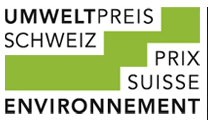Ausschreibung des Umweltpreis der Schweiz 2013
 Umweltpreis der Schweiz: Anmeldeschluss 30. September 2013
Umweltpreis der Schweiz: Anmeldeschluss 30. September 2013
Der Umweltpreis der Schweiz, einer der höchstdotierten Umweltpreise in der Schweiz, wird am 21. Januar 2014 im Rahmen der Swissbau – Leitmesse der Bau- und Immobilienwirtschaft – von der Stiftung pro Aqua - pro Vita vergeben.
Die Kategorie Innovation ist mit 50'000 Franken Preissumme festgesetzt. Es werden Projekte ausgezeichnet, die eine technologie-, verfahrens- oder produktorientierte Innovation im Umweltbereich darstellen. Daneben gibt es den Ecopreneur, den Anerkennungspreis für Unternehmer, die durch ihr nachhaltiges und langjähriges Engagement im Umweltschutz und in der Schonung natürlicher Ressourcen sichtbaren Erfolg am Markt haben.
Ab sofort und bis zum 30. September 2013 können sich Firmen, Organisationen, Institutionen und Behörden, aber auch Privatpersonen bewerben.
Wir würden uns sehr freuen, wenn Sie sich bewerben. Auf umweltpreis.ch finden Sie sämtliche Informationen sowie die Ausschreibungsunterlagen.
Weiter Informationen auf http://www.umweltpreis.ch
David Spichiger, SCS
27.08.2013
EuCheMS Brussels News Update, Aug 2013
<iframe frameborder="0" scrolling="auto" width="100%" height="800px" src="http://us6.campaign-archive2.com/?u=c4a58424d8652d1465429bd26&id=218b4516bc&e=fa5d4ad9f0.xhtml"></iframe>
Otto-Hahn-Preis 2013 an Ferenc Krausz
Der mit 50.000 Euro dotierte und gemeinsam von der Stadt Frankfurt, der Gesellschaft Deutscher Chemiker (GDCh) und der Deutschen Physikalischen Gesellschaft (DPG) getragene Otto-Hahn-Preis wird in diesem Jahr am 20. November in der Frankfurter Paulskirche an Professor Dr. Ferenc Krausz, geschäftsführender Direktor des Max-Planck-Instituts für Quantenoptik in Garching und Leiter der Abteilung für Attosekunden- und Hochfeldphysik, verliehen.
Um die Bewegung von Elektronen in Atomen oder Molekülen direkt zu beobachten benötigt man ultrakurze Laserlichtpulse, sog. Attosekunden-Pulse. Eine Attosekunde ist eine trillionstel Sekunde, also 0,000000000000000001 Sekunden. Krausz und seinem Forschungsteam ist es erstmals gelungen, Attosekunden-Pulse experimentell zu demonstrieren und mit diesen die interatomare Bewegung von Elektronen in Echtzeit wahrnehmbar zu machen. Diese Ergebnisse markieren den Beginn der Attosekunden-Physik und damit einen Meilenstein in der Forschung. Krausz und seinen Mitarbeitern gelang in den letzten Jahren neben Filmaufnahmen der sehr schnellen Bewegung von Elektronen in Molekülen auch die Steuerung der Elektronen. Damit ist zum Beispiel die Kontrolle der optischen und elektrischen Eigenschaften von Dielektrika möglich. Auf dieser Grundlage sind rein optische Schaltkreise realisierbar.
Die Vorarbeit für diesen Durchbruch leistete Krausz mit seinem Team in den 90er Jahren mit eine ganzen Reihe von Innovationen zur Weiterentwicklung der Femtosekunden-Lasertechnologie bis an ihre ultimative Grenze – bis hin zu Lichtpulsen, die den überwiegenden Teil ihrer Energie in einer einzigen Schwingung des elektromagnetischen Felds tragen. Krausz' Gruppe konnte im Jahr 2001 erstmals einen Attosekunden-Lichtpuls (aus extrem ultraviolettem Licht) sowohl erzeugen als auch messen und wenig später damit auch die Bewegung von Elektronen auf subatomarer Skala in Echtzeit verfolgen. Die von Krausz und seinem Team demonstrierte Kontrolle der Wellenform von Femtosekunden-Pulsen und den daraus resultierenden reproduzierbaren Attosekunden-Pulsen erlaubten die Etablierung der Attosekunden-Messtechnik wie sie heute als technologische Basis für die experimentelle Attosekunden-Physik dient.
Krausz hat seine akademische Ausbildung in Budapest und Wien absolviert. Im Jahr 2003 wurde er als Direktor an das Max-Planck-Institut für Quantenoptik in Garching berufen. 2004 übernahm er zudem den Lehrstuhl für Experimentalphysik an der Ludwig-Maximilians-Universität München. Krausz ist einer der beiden Sprecher des 2006 von ihm mitbegründeten Exzellenzclusters Munich Centre for Advanced Photonics (MAP).
Die Stadt Frankfurt, die Gesellschaft Deutscher Chemiker und die Deutsche Physikalische Gesellschaft ehren den Begründer der „Atto-Science“ am 20. November 2013 in der Paulskirche.
Wissenschaftlicher Pressedienst Chemie Nr. 35/13 der GDCh
Frankfurt a.M., 07.08.2013
Invitation to the SCS General Assembly
SCS General Assembly 2013
September 6, 2013, 14.00-15.00
EPFL Lausanne, Building Central East (CE), Auditorium CE 6
The Board of Directors invites all members of the Swiss Chemical Society and the delegates of its associated societies to the 23nd General Assembly.
Agenda
- Welcome and approval of the agenda
- Election of the vote counters
- Minutes of the 22nd General Assembly from September 13, 2012 in Zurich (published in CHIMIA 10/2012, p. 808-809)
- Annual report 2011 (published in CHIMIA 1-2/2013, p. 91-96)
- Financial statement 2012 incl. audit report
- Discharge the Board
- Elections
- News and strategic projects
- Outlook 2013/14
- Varia
Additional agenda topics can be submitted until August 23, 2013 to
Swiss Chemical Society (SCS)
Prof. E. Peter Kündig David Spichiger
President Executive Director
David Spichiger, SCS
07.08.2013
EuCheMS Newsletter 09/2013
![]()
Articles
- Budapest: EuCheMS meetings and Energy Conference
- Report on organic electronics
- Germany’s chemistry conference in Darmstadt
- Events 2013/14
- News from the European Chemistry Thematic Network
More information:
http://www.euchems.ch
David Spichiger, SCS
30.07.2013
Page 161 of 299
